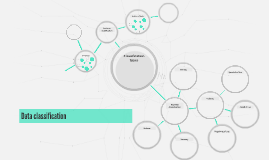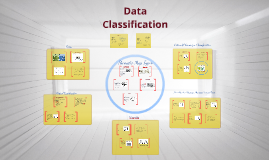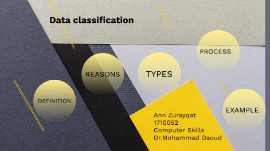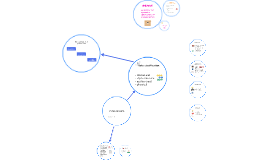Data classification
Transcript: Ann Zurayqat 1710052 Computer Skills Dr.Mohammad Daoud Data classification A DEFINITION OF DATA CLASSIFICATION DEFINITION Data classification is broadly defined as the process of organizing data by relevant categories so that it may be used and protected more efficiently. On a basic level, the classification process makes data easier to locate and retrieve. Data classification is of particular importance when it comes to risk management, compliance, and data security. Data classification involves tagging data to make it easily search-able and track-able. It also eliminates multiple duplications of data, which can reduce storage and backup costs while speeding up the search process REASONS FOR DATA CLASSIFICATION REASONS Data classification has improved significantly over time. Today, the technology is used for a variety of purposes, often in support of data security initiatives. But data may be classified for a number of reasons, including ease of access, maintaining regulatory compliance, and to meet various other business or personal objectives. In some cases, data classification is a regulatory requirement, as data must be searchable and retrievable within specified timeframes. For the purposes of data security, data classification is a useful tactic that facilitates proper security responses based on the type of data being retrieved, transmitted, or copied. TYPES OF DATA CLASSIFICATION TYPES Data classification often involves a multitude of tags and labels that define the type of data, its confidentiality, and its integrity. There are three main types of data classification that are considered industry standards: Content based classification inspects and interprets files looking for sensitive information Content based classification looks at application, location, or creator among other variables as indirect indicators of sensitive information Context Context based classification depends on a manual, end-user selection of each document. User-based classification relies on user knowledge and discretion at creation, edit, review, or dissemination to flag sensitive documents. User User THE DATA CLASSIFICATION PROCESS PROCESS Data classification can be a complex and cumbersome process. Automated systems can help streamline the process, but an enterprise must determine the categories and criteria that will be used to classify data, understand and define its objectives, outline the roles and responsibilities of employees in maintaining proper data classification protocols, and implement security standards that correspond with data categories and tags. When done correctly, this process will provide employees and third parties involved in the storage, transmission, or retrieval of data with an operational framework. An organization may classify data as Restricted, Private or Public. In this instance, public data represents the least-sensitive data with the lowest security requirements, while restricted data is in the highest security classification and represents the most sensitive data. This type of data classification is often the starting point for many enterprises, followed by additional identification and tagging procedures that label data based on its relevance to the enterprise, quality, and other classifications. The most successful data classification processes employ follow-up processes and frameworks to keep sensitive data where it belongs. AN EXAMPLE OF DATA CLASSIFICATION EXAMPLE

















